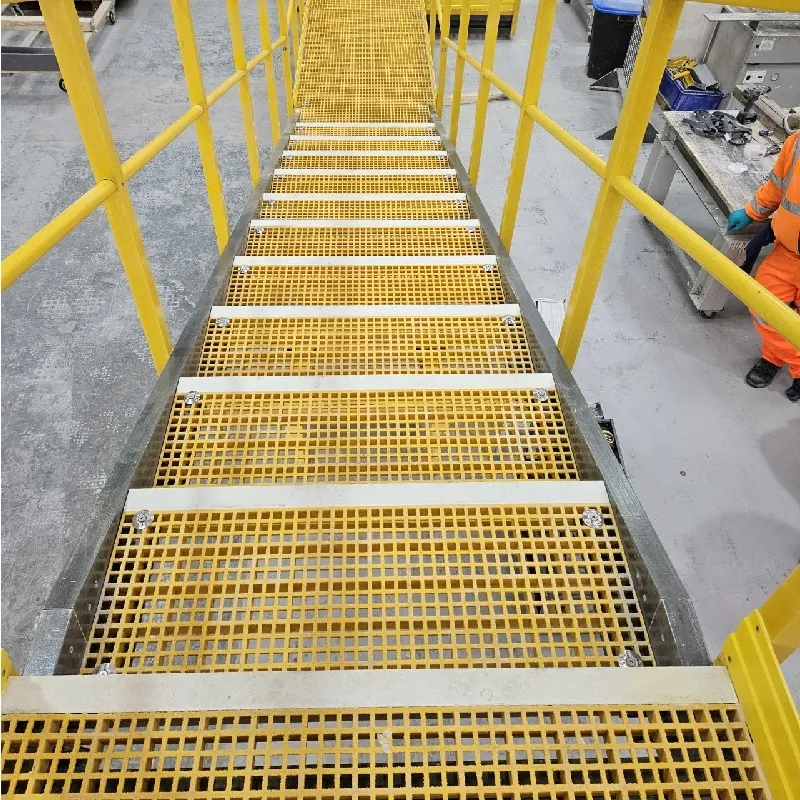loading...
- No. 9, Xingyuan South Street, Dongwaihuan Road, Zaoqiang County, Hengshui, Hebei, China
- admin@zjcomposites.com
- +86 15097380338
- Welcome to visit our website!
grp pultruded grating
Understanding GRP Pultruded Grating Benefits and Applications
GRP (Glass Reinforced Plastic) pultruded grating is an innovative material that has gained popularity in various industrial and architectural applications. This advanced product is manufactured through a process called pultrusion, where raw materials, such as glass fibers, resin, and other reinforcement materials, are drawn through a heated die to create a continuous profile. The result is a lightweight, strong, and corrosion-resistant grating solution that offers numerous advantages over traditional materials. In this article, we will explore the key benefits of GRP pultruded grating, its applications, and why it has become a preferred choice in many sectors.
Advantages of GRP Pultruded Grating
1. Lightweight yet Strong One of the most significant advantages of GRP pultruded grating is its impressive strength-to-weight ratio. Compared to metal grating options, GRP is significantly lighter, making it easier to handle and install. Despite its lightweight nature, it is exceptionally strong and can support heavy loads, making it suitable for various applications, including industrial platforms and walkways.
2. Corrosion Resistance GRP materials are inherently resistant to various corrosive environments, including chemicals, moisture, and saltwater. This property makes GRP pultruded grating an ideal choice for industries such as oil and gas, marine, and wastewater treatment, where exposure to harsh substances is common. Unlike metal grating, which can rust and deteriorate over time, GRP maintains its integrity and appearance even under challenging conditions.
3. Low Maintenance The durability of GRP pultruded grating translates into lower maintenance costs. Since the material does not corrode, it requires minimal upkeep over its lifespan compared to traditional grating solutions. This quality not only economizes maintenance efforts but also prolongs the lifespan of the infrastructure where it is installed.
4. Customizable Designs GRP pultruded grating can be customized to meet specific requirements, including various sizes, colors, and load capacities. This flexibility allows architects and engineers to design innovative solutions that cater to their project needs without being constrained by the limitations of conventional materials.
5. Safety Features Many types of GRP grating are designed with slip-resistant surfaces, making them a safe option for walkways, platforms, and other pedestrian areas. This feature is crucial in environments where spills or exposure to moisture can create slipping hazards. Additionally, GRP is non-conductive, making it a safe choice for electrical environments.
grp pultruded grating

Applications of GRP Pultruded Grating
1. Industrial Applications GRP pultruded grating is widely used in various industrial settings, including chemical processing plants, power generation stations, and manufacturing facilities. Its strength and corrosion resistance make it suitable for platforms, staircases, and other structural elements requiring reliable support.
2. Marine Environments In the marine industry, GRP grating is often employed on docks, piers, and walkways. Its resistance to saltwater and UV exposure ensures that it maintains its performance and appearance, reducing the need for replacement or repair.
3. Wastewater Treatment GRP pultruded grating is an excellent choice for wastewater treatment facilities. The material’s resistance to chemical exposure, combined with its strength and durability, makes it ideal for areas where harsh conditions are present.
4. Architectural Applications Beyond industrial use, GRP pultruded grating is also finding its way into architectural projects. With its customizable designs and aesthetics, it can be used in flooring, decking, and other decorative elements, enabling designers to achieve unique looks while benefiting from its practical advantages.
5. Transportation Infrastructure GRP grating is increasingly used in transportation infrastructure, such as railway platforms and pedestrian walkways. Its lightweight nature allows for easy installation while ensuring that it meets safety standards and load requirements.
Conclusion
In summary, GRP pultruded grating presents a versatile, durable, and cost-effective alternative to traditional grating materials. Its unique properties, including corrosion resistance, lightweight structure, and low maintenance requirements, make it an excellent choice for a variety of applications across multiple industries. As industries continue to look for innovative solutions to combat the challenges posed by corrosive environments and the need for sustainable materials, GRP pultruded grating stands out as a key player in modern engineering and design. Whether for industrial, marine, or architectural applications, the benefits of GRP pultruded grating are undeniable and will likely lead to its increased adoption in the future.
-
GRP Structures: The Future of Lightweight, High-Performance EngineeringNewsJun.20,2025
-
FRP Water Tank: High-Performance Storage for Corrosive and Clean Water SystemsNewsJun.20,2025
-
FRP Square Tube: The New Industry Standard for Chemical and Structural ApplicationsNewsJun.20,2025
-
FRP Pultruded Profiles: The Ultimate Choice for Lightweight Structural StrengthNewsJun.20,2025
-
FRP Handrails: The Safer, Smarter, and Stronger Choice for Modern InfrastructureNewsJun.20,2025
-
FRP Grating: The Smart Solution for Durable, Lightweight Industrial FlooringNewsJun.20,2025
-
Why Choose a Galvanized Water Tank for Your Storage NeedsNewsMay.21,2025
